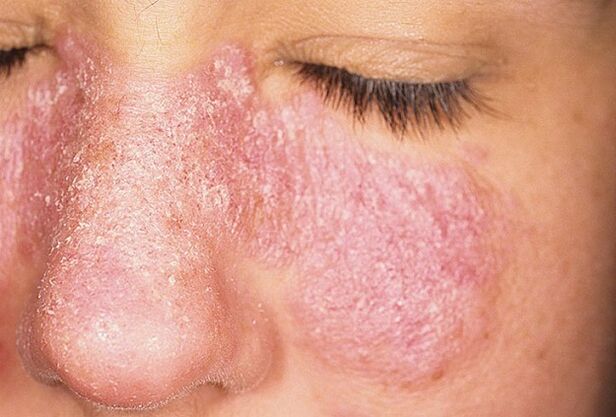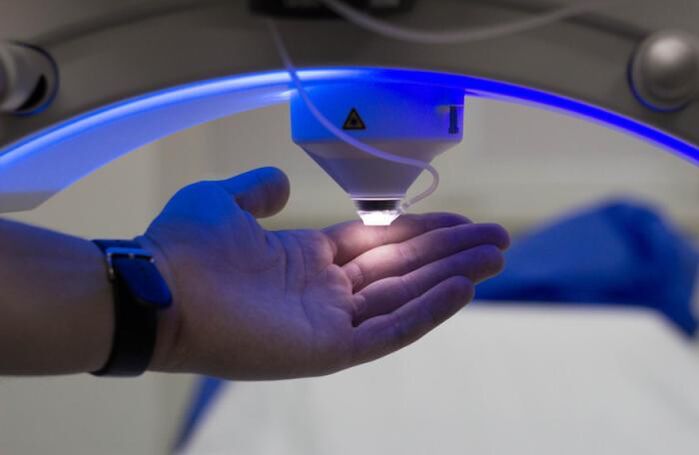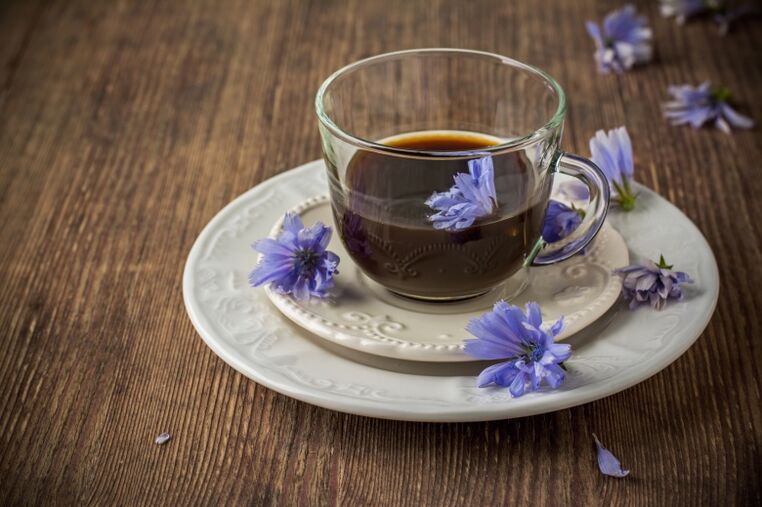Tired of fighting psoriasis on your face? You do not know what can cause its appearance and how to accurately recognize this disease? Would you like to learn about traditional treatment recipes? Looking for information on modern hardware techniques to combat the disease? You will find this and other interesting information in our article!
What is psoriasis on the face?

A non-infectious autoimmune disease that manifests itself in severe reddening of the skin and the appearance of small scales (papules) on its surface, which gradually grow and merge with each other, is called psoriasis. In this case, the person experiences itching and discomfort, which is accompanied by the disgust of others, who do not understand that this disease is not spread through everyday contact.
The cause of this insidious disease cannot be reliably identified even with the modern level of development of medicine. It is believed that the disease is provoked by hereditary factors, disorders of the immune or endocrine system, disorders of lipid metabolism, and constant stressful situations.
Psoriasis is most often localized on the face around the eyes and temples, eyebrows, nasolabial folds, and border zones near the scalp.
There are two types of psoriasis: vulgar (the most common) and seborrheic. Unlike vulgar seborrhea, it is considered a more complex form of the disease, as it is characterized by the appearance of particularly dense and large papules and scales covered with a layer of sebum with a yellowish tint. It is a common belief that seborrhea (increased sebum production) is the cause of this form of psoriasis.
The course of the disease is accompanied by periods of remission (disappearance of symptoms) and relapses (recurrence of symptoms after a certain period of time).
Typical signs of psoriasis
In order to correctly recognize and determine the presence of psoriasis, and not other dermatological problems, you need to know the following main symptoms of the disease.
- If you run your nail plate over plaques with scales that appear on the surface of the skin, you will notice increased peeling in this area later. This mark is called a stearin spot because it resembles a drop of frozen wax, which forms many peeling plates when touched with a finger.
- During the thorough cleaning of the skin of the scales that appear, a thin, bright red film will be visible on the surface of the epidermis. This feature is called terminal film.
- After the terminal film is removed from the surface of the skin by scraping, small, multiple pinprick hemorrhages are observed in the form of small drops. This bleeding is caused by the fact that the capillaries are located close to the epidermis, which are easily damaged during the disease. This phenomenon is called blood dew.
The plaques and papules that form in psoriasis grow and increase in size rapidly. They merge to form a single conglomerate that distorts the affected area of the face. Do not comb or remove the crusts from the affected areas of the skin, so as not to provoke the appearance of scars.
Stages of psoriasis
The clinical manifestation of psoriasis on the face has 3 main stages:
- Advanced. It is characterized by an increase in the size of existing plaques and their fusion into a single spot with the active appearance of new papules, as well as a bright red, flaky rash against a background of severe itching. When you scratch, new rashes appear.
- Stationary. It is characterized by stopping the growth of papules with a noticeable reduction in peeling. Existing plaques take on a blue tint and itching is less pronounced.
- Decreasing. This stage involves masking all the symptoms of the disease. All manifestations of psoriasis become almost invisible. Peeling and itching disappear completely, papules and plaques begin to dissolve.
Recommendations for psoriasis skin care
In such a situation, it would be correct to immediately contact a specialist - a dermatologist who will conduct a comprehensive examination of the body, determine the extent of skin damage, prescribe professional treatment and tell you how to properly care for it. skin affected by psoriasis. If for some reason you can't see a doctor right now, listen to the following tips and recommendations.
- Use cosmetic cleansing and facial care products designed for sensitive skin to prevent damage and further aggravation of the condition.
- After washing, avoid vigorous rubbing of the affected skin area. It is best to dry these areas with a paper towel, carefully apply to the problem areas.
- It is worth temporarily (before visiting a doctor) to stop using cosmetics, including decorative cosmetics.
- Do not use scrubs and exfoliating substances, which can cause inflammatory reactions and worsen the situation.
- Men who use razors should replace them with electric razors, which are less damaging to the surface of the epidermis.
Possible treatment options for the disease
The treatment method is presented for general information and information purposes only. Do not self-medicate! Be sure to consult a specialist in order to receive an individual and comprehensive therapy suitable for you!
After examining and evaluating the nature of the disease, the dermatologist will select the most appropriate treatment option for you, which may include:
- Medicines for internal use (tablets, injections).
- Suitable ointments, emulsions and cosmetic vegetable oil preparations for external use.
- All kinds of physiotherapy procedures with special tools and instruments.
- Properly chosen diet and lifestyle recommendations.
- Products intended for home use (waters, ointments).
Medicines used for internal treatment
Usually, such a disease means taking the following drugs: cytostatics, immunosuppressants, glucocorticosteroids, biologically active drugs.
Systemic therapy can be prescribed in the form of taking pills or injecting drugs that have a targeted and comprehensive effect and relieve the feeling of itching.
For external use, mixtures containing naphthalene and salicylic ointments and corticosteroids are most often prescribed.
Moisturizing and vitamin preparations are used for general toning and strengthening of the skin's local immunity.
Physiotherapy treatments

- Ultraviolet lamps, the effect of which is based on the effect of UV rays, which means the growth of pathological cells of the epidermis and the general improvement of the skin. The method was found to be quite effective.
- Phototherapy performed under the supervision of a specialist is based on exposure to UV radiation of a certain frequency. This method has received many positive reviews.
- The excimer laser used in special clinics is the most modern and effective tool that helps to actively fight psoriasis.
Dietary indications
Consuming large amounts of vegetables, fruits, berries, herbs, fish, lean meat, dairy products and cereals is recommended.
The ban extended to fatty, hot, spicy, smoked, fried foods and foods, as well as sweets, baked goods, nuts and whole milk.
During treatment, smoking and drinking alcoholic beverages are strictly prohibited.
Used ointments and creams
Non-hormonal ointments and creams are primarily used to treat psoriasis on the face, as they are considered the safest. As an example, we can mention the most common and most frequently prescribed ointments based on fat, essential oil and plant extracts, the use of which must fully comply with the instructions. They give a temporary result, after long-term use they have an addictive effect.
Folk recipes
By finding and choosing the ingredients needed to make homemade ointments, you can get an effective treatment for psoriasis, which has a therapeutic effect after 4 weeks of regular use.
Apply these compounds only to clean, dry skin in small amounts and in a thin layer.
| Recipe number | Ingredients in the composition, quantity | Manufacturing notes |
|---|---|---|
| 1 |
|
After mixing all the components of the preparation, keep it in a dark, cool place for 15 days. |
| 2 |
|
Mix all ingredients thoroughly and infuse in a cool, dark place for 3 days. |
| 3 |
|
Mix the ingredients thoroughly and store in a dark place for 3 days. |
The treatment of psoriasis with Dead Sea salt is effective, thanks to the special composition of its minerals, which easily penetrate the epidermis, providing a healing, anti-inflammatory and astringent (drying) effect. We recommend adding this salt to the thermal water and spraying problem areas of the epidermis with this preparation several times a day.
The natural essential oils of coconut, borage, juniper, yarrow, lavender, jojoba, tamanu, and sea buckthorn have achieved excellent results with regular use.
Compositions for internal use

- The tincture of the fruits of the Chinese lemongrass, taken 20-30 drops three times a day before meals, helps the body actively fight against harmful environmental factors.
- It is recommended to drink ¼ cup of common chicory decoction 4 times a day. It strengthens immunity and has a calming effect.
- Ointments made from Kalanchoe pulp (the leaves are ground to form a paste) perfectly cleanse the skin of plaques and papules. Using a patch, apply the mixture to the affected areas of the skin and leave it on for 4 hours.
- Mix celandine juice (fresh plant) with marigold infusion in a ratio of 1: 1. Apply this mixture to problem areas once a day.
Use folk remedies, but don't forget to consult your doctor!























